In order to hook up Earth with my fictional land of Flimsy in my novel-in-progress Jim and the Flims, I’ve been thinking about using an STM (Scanning Tunneling Microscope) to poke a hole in an atom or, even better, into an electron. And this produces a tunnel to an alternate world. Simple!
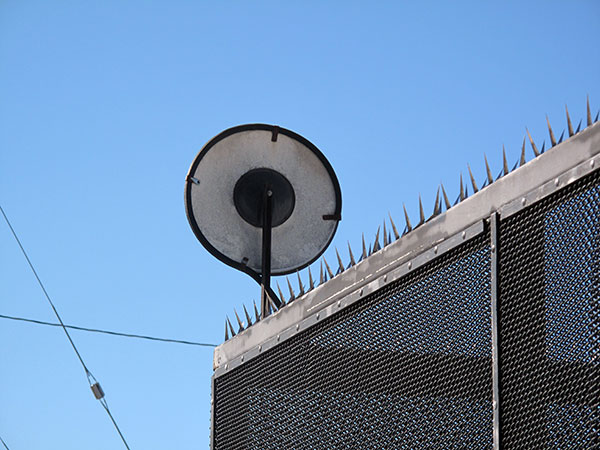
Really you’d need some SFictional way to amp up the power of the thing—maybe I fall back on that hoary SF-movie expedient of a well-timed stroke of lightning on a nearby power pole. I see this happening on some slacker’s hobby porch, not in an intergovernmental lab. I gather that it’s possible to build your own STM at home.
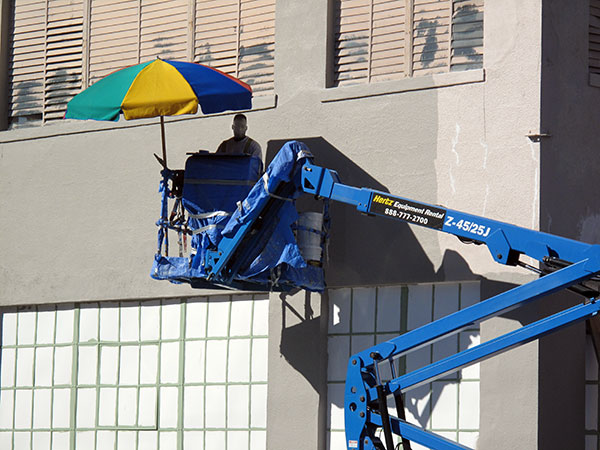
Somehow he’s virtually riding on his picometer needle and … Zzzzzt!
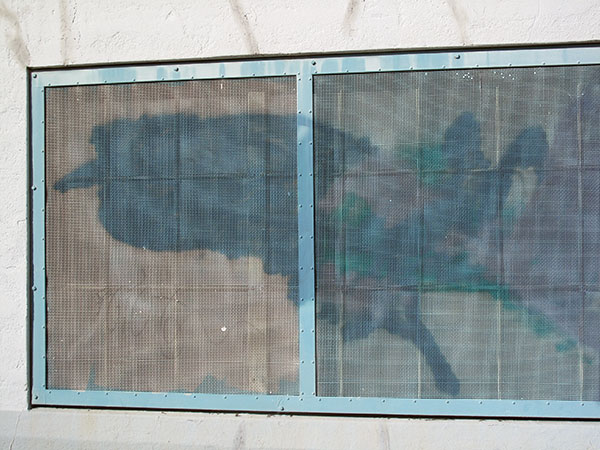
There’s some nice STM pictures on the IBM Almaden Labs site. (The photo above shows the results, however, of San Francisco graffitti removal, not the machines at IBM.)
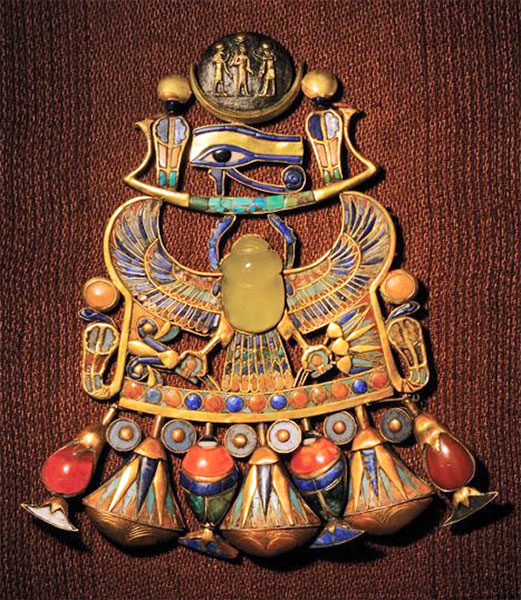
Photo by Kenneth Garrett, Copyright (C) 2008, National Geographic
We went to see the King Tut show at the De Young Museum in San Francisco this weekend. It was a good show, with some gorgeous things. I loved this “pectoral” or necklace.

[Photo from www.suite101.com, Credit: Credit: Egyptian Museum/Andreas F. Voegelin]
Even better was the gilded coffin of Tjuya, who may have been Tut’s mother-in-law. Ride the boat to heaven.
I pick up cultural associations of the 1920s and 1960s when I look at Egyptian art. Howard Carter discovered Tut’s tomb in the 1920s—I just read Carter’s fascinating account of it in a Dover reprint called The Discovery of the Tomb of Tutankhamen—this is a great little book. And in the 1920s there was a fad for Deco and Egyptian stuff.
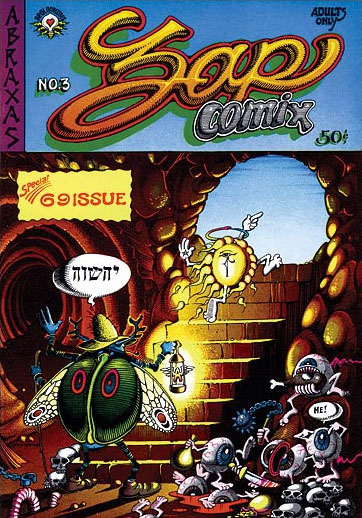
[Art by Rick Griffin for Zap #3, (C) Rick Griffin]
The psychedelic rock posters and cartoons of the 1960s often used to feature flying scarabs—I think particularly of the work by Rick Griffin.
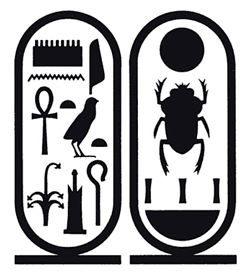
[Found on Wikimedia Commons.]
This pair of cartouches contains the hieroglyphic signs that render Tutankhamen’s name. I’ll give an explanation that’s partly or even largely wrong. (A cartoonist named Chris Cooper has posted a more accurate illustrated essay about Tut’s name.)
The cartouche on the left is his more informal name, Tut (chicken) + Ankh (hippie cross) + Amun (earth, air, and sea) and under that a Crook for Ruler, an On (butter churn?) for the city Heliopolis, and a Papyrus plant for Upper Egypt, or Thebes. The cartouche on the right represents his throne name, “Nebkheperura.” Here we have Ra=God (sun disk) + Khephri (Scarab) + Neb (Basket, stands for All).

Sylvia pointed out that one of the ankhs on display had a woman’s lower body sketched on it, right below a Nebkheperura cartouche. I’d never thought of the Ankh that way.
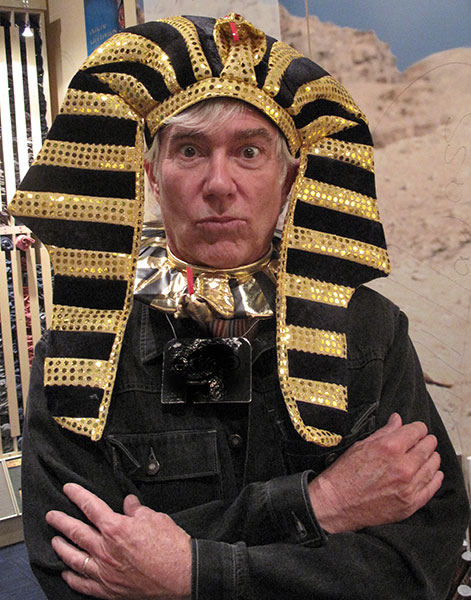
It felt so weird to come out of the tomb-like show into the museum shop, three thousand years later, and a half a world away from Tut’s tomb and everyone is imitating Tut and taking pictures.
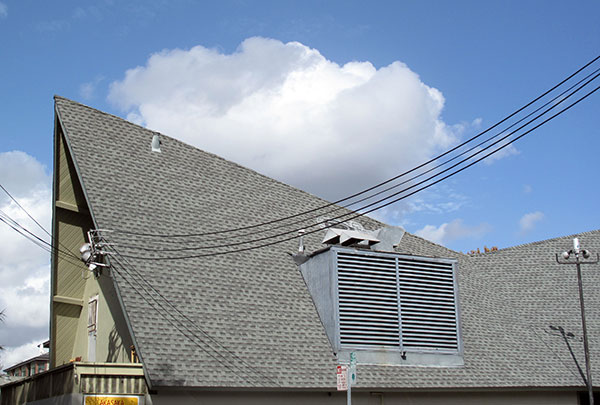 [Sarcophagus-like Scanadavian pancake house on Telegraph Ave. in Berkeley, converted to a sushi resaurant.]
[Sarcophagus-like Scanadavian pancake house on Telegraph Ave. in Berkeley, converted to a sushi resaurant.]
Certainly there should be some Egyptian stuff in my fictional land of Flimsy. A flying snake. A great scarab. But maybe in a diner.









October 28th, 2009 at 8:16 pm
how about tunneling into some dark matter? of course first you have to capture some — but its everywhere so that should not be a problem. all you need is a gravity well to capture the dark matter, once you gather enough it turns out that it makes a natural tunnel into your alternate world. of course this is all easy once you figure out how to produce a few gravitons. maybe that’s what pyramids did for the Egyptians. …
October 29th, 2009 at 1:41 pm
I remember when that building was “Michael’s Vegetarian Restaurant.” It didn’t do that well.
October 30th, 2009 at 6:44 am
RETURN OF THE MUMMY
I was having my third one when I heard someone settle down on the next stool and wheeze “Straight whiskey, please.” It was such a strange accent and a weird dry voice that I glanced up from the puddle of beer I was drawing circles in to see the owner. He was shriveled and dry-looking, just as his voice had led me to expect. He was hunched forward, and the fingers that he extended to grasp the shot glass were like sticks. Under a shapeless hat his face was wrinkled and gray, and beneath his long trenchcoat I could see the wraps and folds of ancient grimy bandages.
No doubt about it; the guy sitting next to me was the Mummy.
He sipped carefully on his drink. Probably afraid of fires, I mused. Maybe he’s just whiffing the fumes and not really imbibing the stuff. He saw me watching and glanced over.
“I used to hang out over at Gavagan’s, but it shut down a few years back. Now I drop in here whenever I’m in town.” His voice was a bit smoother now, so maybe the whiskey actually did him some good. Wet his whistle.
“You, uh, travel around a lot?” I pictured him hitchhiking, or maybe mailing himself in a dusty sarcophagus. He cracked a smile, almost literally.
“It’s the curse,” he said briefly, tilting the shotglass to his clenched teeth.
“Curse?” I gave him the straight line, rolling my eyes. The kooks always sit next to me in a bar, I swear they do. Maybe I’m cursed.
“King Tut’s Curse,” he explained, tapping the glass against his teeth to get the last drop. Setting the glass on the bar, he continued. “You remember old King Tut? Dug him up in 1922? Put him in a museum?” I nodded, or grunted; he continued. “Well, there’s this curse. ‘Whosoever opens the sarcophagus or gazes upon the face of the mummy inside must die by the hands of the servant of the curse.’ That’s me, servant of the curse. Hell of a job.”
I ordered two more shots, good stuff this time, not the crappy stuff he was drinking. He tasted carefully, then trickled more inside his lips and shook his head from side to side.
“So I’m working along, whacking the people who dug him up, until they died from old age because I couldn’t catch them mostly, and watching the museum to see who visited the Tut exhibit and trying to shadow them home and kill them. Do you know how hard it is to follow people home when you’re a living mummy? Cabs won’t stop for you, I swear they won’t. I was already way behind when they put him in a traveling exhibit, and it got completely out of hand.”
I gulped my shot as if it had been cheap bar whiskey and staggered to my feet. “You mean – ” I gasped.
“Oh yes,” the Mummy replied. “I’m compelled by the curse to track down and kill every one of the thousands of people who saw the King Tut exhibit on tour in the nineteen-seventies.”
November 8th, 2009 at 10:14 am
Rudy,
Good stuff here. Really appreciated the take on Egyptian art influence on the periods of the 1920s and the Sixties. Especially the stuff on Rick Griffins. I’ve heard the travelling Tut Show is a bit Disney-fied, but I think I’ll try to make it before it leaves the country all the same.